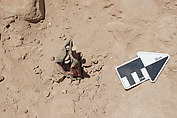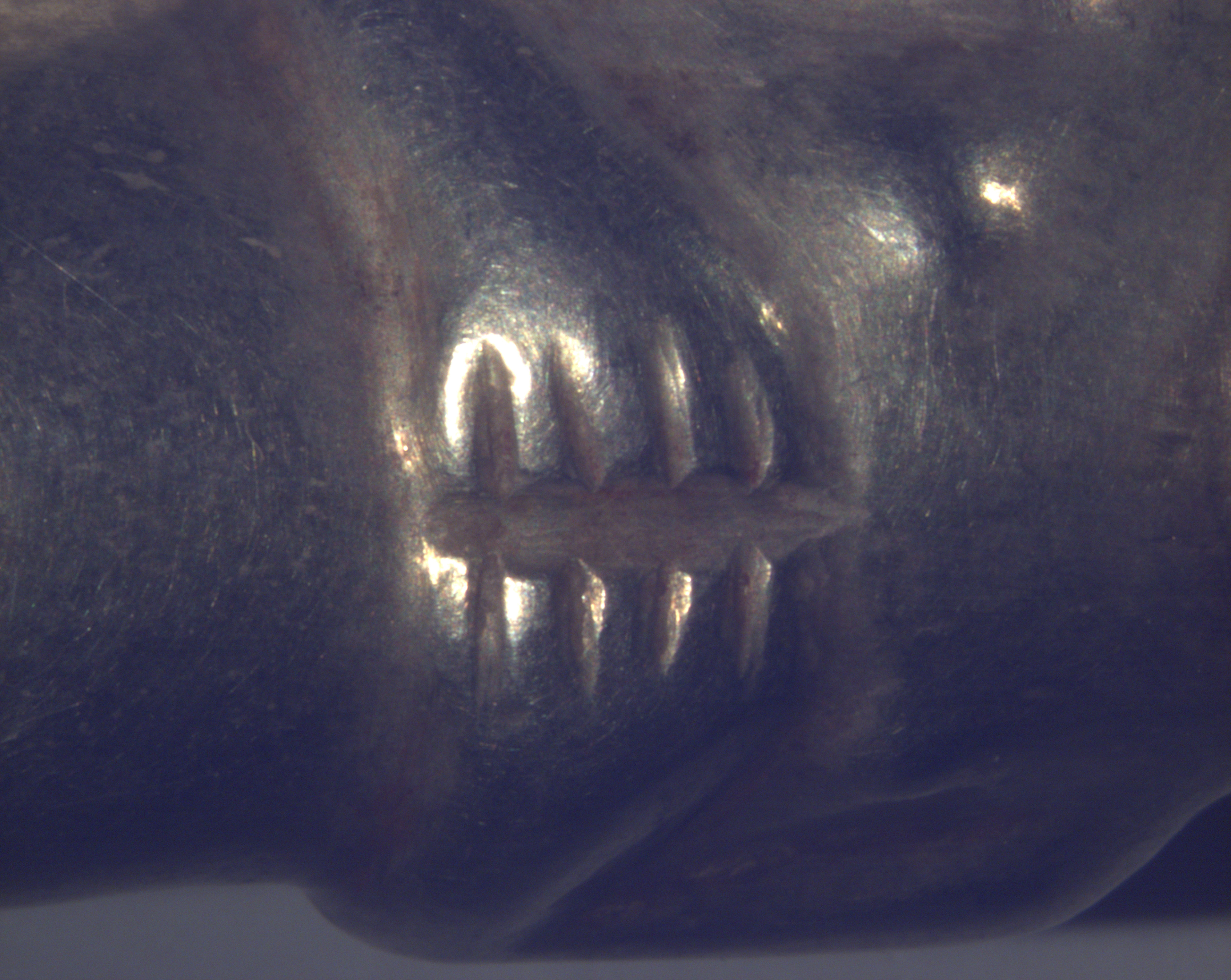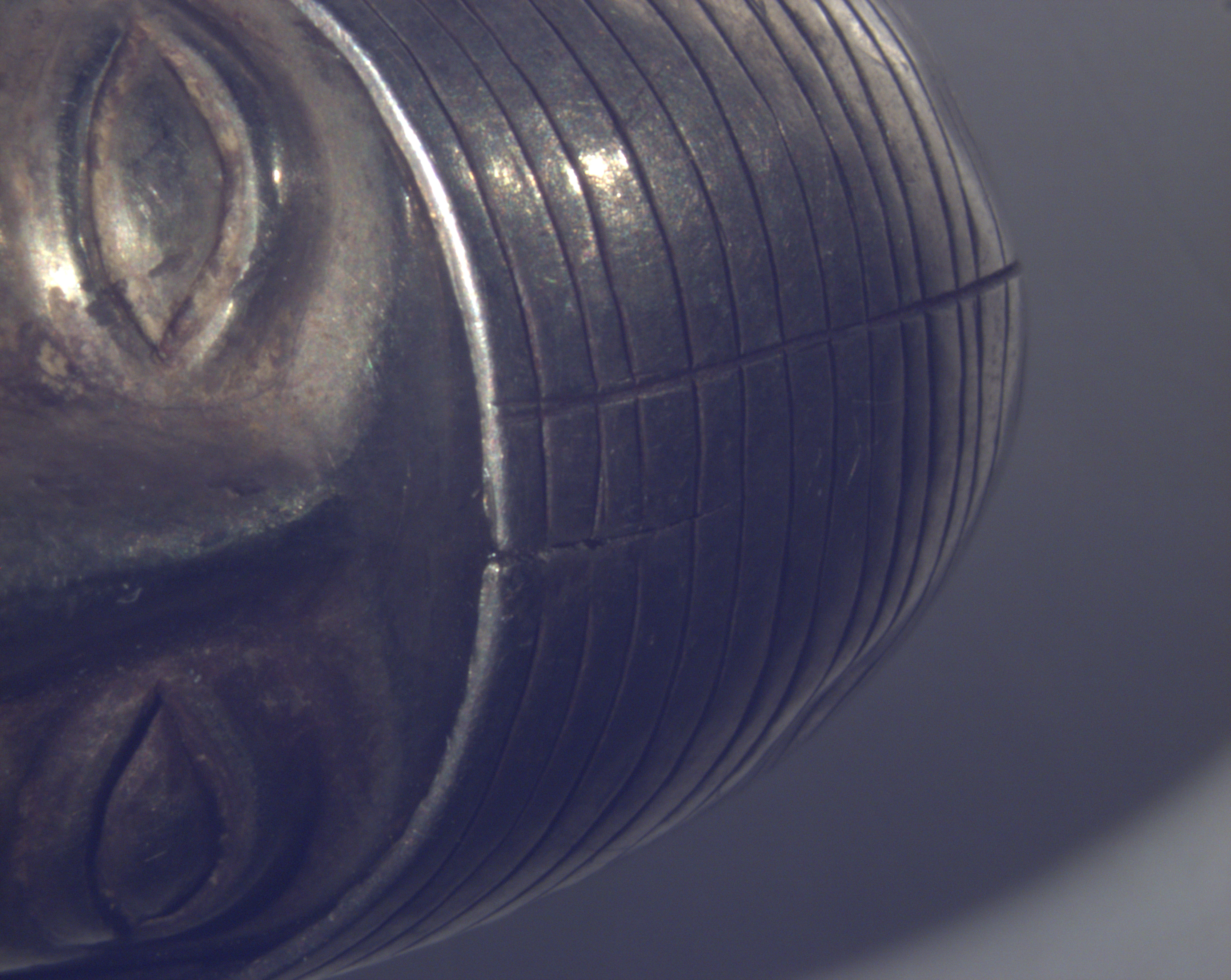Miniature female effigy
Not on view
This female figurine is hollow and composed of worked sheet metal of a gold-rich silver alloy. The subject is a woman in a pose comparable to a range of other Inca metal figurines that depict women. The head is notably large relative to the rest of the body, and the eyes are almond-shaped. The figure stands upright with hands and arms pulled close to the chest, and with hair pulled back into two tresses fastened with a tassel, similar to the tassel or ribbon worn by women in the Peruvian altiplano today (Valencia 1981, 57). Within the corpus of Inca anthropomorphic metal figurines, there are essentially three height groups (5-7 cm, 13-15 cm, 22-24 cm), and this object is in the smallest height group. The place where this figurine was deposited is unknown. However, it was likely deposited as part of an Inca offering to a huaca (a Quechua and Aymara language term for a sacred entity). These huacas range from a rock to a river to a mountain. The figure itself also can be conceived as a huaca, having its own camay (a Quechua language term), an energizing power (see Bray 2015; Cruz 2009; Trever 2011). These figurines, along with rocks or other natural forms, may have played a role as active agents in the negotiation of power within the Inca Empire. For instance, other huacas served as ‘doubles’ for Inca royalty who demanded that people revere such representations as if they were royalty themselves (Trever 2011; Valencia 1981).
Though the figure here is now unclothed, some analogous female metal figurines from Inca contexts, including Ampato in Peru (Onuki and Rojas 2000) and Llullaillaco in Argentina (MAAM 2007), were found wrapped in miniature textile garments fastened by tupus (metal pins) and adorned with feather headdresses. They may be accompanied by other figurines in shell (Spondylus spp.) often in the same general shape as the metal ones along with Inca ceramic and wooden vessels, including qeros used for drinking, and chuspas, or textile bags for coca. At Ampato and Llullaillaco, among others in regions of contemporary Peru, Argentina, Ecuador and Chile, there is evidence of depositions related to the ritual performance of capac hucha, or ‘royal obligation’, an Inca imperial practice. According to 16th century Spanish chronicler Juan Diez de Betanzos (1996, 46, 132) this practice involved children brought from different locales to Cuzco, the capital of the Inca Empire, where they were paired and married and then sent on processions to various sites brought into the fold of the Empire. On arrival at these destinations, they were killed and buried with a range of materials, including metalwork. There were several imperial motivations for the capac hucha performance. One was to mark the geographic expansion of Inca territory. Another was to commemorate certain royal events, such as the death of a ruler. Elements of these capac hucha assemblages may be involved in other types of offerings, such as the deposition of camelid figurines in metal and shell in a line associated with stones of the usnu, or altar, of Cuzco as part of the dedication of sacred space in the Haukaypata, or main plaza (Farrington and Raffino 1996, 73). Another instance of figurine deposition, in the absence of human remains, which may or may not be a case of capac hucha, is an Inca offering in Unit 16, Platform 1 of the Moche site of Huaca de la Luna. There, a female anthropomorphic figurine made of Spondylus princeps was found wrapped in miniature textile garments (an aksu, lliclla, and faja), fastened by tupus, two of which are connected to a cord from which hang Spondylus plaques (Rojas et al. 2012) (see image 3). The disruption of sacred sites through excavation and exhibition does deserve consideration; for more information about the circumstances of Llullaillaco, please see Aguero 2004, Fine-Dare 2009, and Politis 2001, 99-101.
The figure was formed from separate sections of metal sheet. The head and body section was made by working a flat sheet into an approximate cylinder, joining the two vertical ends along the back (here overlapping left over right), and cutting the sheet to enable the two legs to be wrapped into thin cylinders yet remain attached to the main body. At the groin small triangular cuts or cracks are visible where the metal was worked to create the legs, though in other similar figurines this area is both concealed and reinforced by an additional saddle-shaped gusset, or filler piece, closing the now-open space between the legs (cf. Lechtman 1996, 309). X-radiography reveals that the hair section is soldered to the figure along the sides, forehead, and down the back (see image 4, front-back view); the head underneath the hair is open at the back and upper shoulders (see image 4, profile view). All of the metal sections appear to have been joined by the use of solder.
The details of the figurine – facial features, arms and hands, and breasts – would have been hammered into the metal sheet before the figure itself was fully formed. Additional shaping and sharpening of the eyes, nose, mouth and fingers, as well as a small indentation in the groin indicating the sex of the figurine, were accomplished by tracing or engraving the metal from the front (see image 5).
The hair piece itself is engraved or incised with lines that define the hair’s coiffure. As with other Inca female human figurines in metal, a line has been drawn along the center of the head from the front of the hair where it meets the forehead, toward the back (see image 6). This line was most likely made before the sheet was shaped, and may have served to guide the overall symmetrical design of the hair piece. A deep hammered depression or concave fold runs vertically down the back of the hair, with thin diagonal incised lines along both sides to represent plaits; their somewhat discontinuous nature suggests they were added after the piece was formed. This figure stands apart from some others in that the incised center line ends well before it meets the concave fold, at the crown of the head (see image 7).
The figurine in its present state reveals many aspects of its original fabrication as a result of the previous separation and loss of some of its sheet components. Currently it is composed of two sections of metal – the head, torso and legs (one piece), and the hair. The figurine would also have had small flat feet made of sheet metal. The gusset at the groin and both feet have been lost. The hair piece is missing a section along the left side, including the left tassel. It appears that the hair section may have at one point become partially or wholly detached, as there are the remains of a recent adhesive here. There is a short crack at the forehead adjacent to the incised center line.
The missing feet were likely soldered to the leg pieces and potentially secured with cylindrical extensions into the legs; one similar figurine from Isla de la Plata in Ecuador (Field Museum 4450) shows pins securing the legs (Cockrell et al. n.d.). On this figure, the proper right leg interior shows some material inside the opening, but the x-radiograph shows it is not metallic and likely represents an earlier repair or restoration.
This figurine’s fabrication process and physical appearance are consistent with other Inca human figurines made of worked metal sheet, though it is now missing some of its characteristic components. The same general morphology and design details are also apparent on Inca human figurines made of the shell Spondylus spp. It is important to consider when and to whom the fine technical work of these figurines was visible. While the offering materials may have been displayed separately in processions inside and out of Cuzco, the figurines were intended, as part of the functioning capac hucha assemblage, to be wrapped in textiles, largely hidden by and from the other assemblage components.
Technical notes: Optical microscopy, X-radiography, and XRF conducted in 2017.
Bryan Cockrell, Curatorial Fellow, AAOA
Beth Edelstein, Associate Conservator, OCD
Ellen Howe, Conservator Emerita, OCD
2017
References
Aguero, Adrian. Violan derechos de las momias del Llullaillaco. Argentina Indymedia. Last modified August 24, 2004, http://argentina.indymedia.org/news/2004/08/218027.php
Bray, Tamara. “An Archaeological Perspective on the Andean Concept of Camaquen: Thinking Through Late Pre-Columbian Ofrendas and Huacas.” Cambridge Archaeological Journal 19, no. 3 (2009): 357-366.
Cockrell, Bryan, Colin McEwan, Patrick Ryan Williams, and Laure Dussubieux. “The Ritualized Production of an Inca Assemblage from Isla de la Plata, Ecuador”. Unpublished manuscript.
Cruz, Pablo J. “Huacas olvidadas y cerros santos: apuntes metodológicos sobre la cartografía sagrada en los Andes del sur de Bolivia.” Estudios Atacameños (San Pedro de Atacama) 38 (2009): 55-74.
Diez de Betanzos, Juan. Narrative of the Incas. Translated and edited by Roland Hamilton and Dana Buchanan. Austin: University of Texas Press, [1551-57] 1996.
Farrington, Ian, and Rodolfo Raffino. “Mosoq suyukunapa tariqnin: Nuevos hallazgos en el Tawantinsuyu.” Tawantinsuyu 2 (1996): 73-77.
Fine-Dare, Kathleen S. “Bodies Unburied, Mummies Displayed: Mourning, Museums, and Identity Politics in the Americas.” In Border Crossings: Transnational Americanist Anthropology, edited by Kathleen S. Fine-Dare and Steven Rubenstein, 67-118. Lincoln: University of Nebraska Press, 2009.
Lechtman, Heather. “Technical Descriptions.” In Andean Art at Dumbarton Oaks, edited by Elizabeth Hill Boone. Washington, D.C.: Dumbarton Oaks Research Library and Collection, 1996.
Museo de Arqueología de Alta Montaña (MAAM). Museo de Arqueología de Alta Montaña. Buenos Aires: Fondo Nacional de las Artes, 2007.
Onuki, Yoshio, and Fernando Rosas Moscoso. Exposición del gran Inca eterno: la tristeza de la niña "Juanita". Lima: Museo Nacional de Arqueología, Antropología e Historia del Perú and Museo Santuarios Andinos, 2000.
Politis, Gustavo. “On Archaeological Praxis, Gender Bias and Indigenous Peoples in South America.” Journal of Social Archaeology 1, no. 1 (2001): 90-107.
Rojas, Carol, Moisés Tufinio, Ronny Vega, and Mirtha Rivera. “Unidad 16 - Plataforma I de Huaca de la Luna.” In Proyecto Arqueológico Huaca de la Luna: Informe técnico 2011, edited by Santiago Uceda and Ricardo Morales, 75-127, Trujillo: Universidad Nacional de Trujillo, Facultad de Ciencias Sociales Trujillo, 2012.
Trever, Lisa. “Idols, Mountains, and Metaphysics in Guaman Poma's Pictures of Huacas.” RES: Anthropology and Aesthetics 59/60 (2011), 39-59.
Valencia Espinoza, Abraham, Metalurgia Inka: Los ídolos antropomorfos y su simbología. Cuzco, 1981.
Due to rights restrictions, this image cannot be enlarged, viewed at full screen, or downloaded.
This artwork is meant to be viewed from right to left. Scroll left to view more.







